调制传递函数和调制传递函数曲线
- 格式:doc
- 大小:179.00 KB
- 文档页数:6
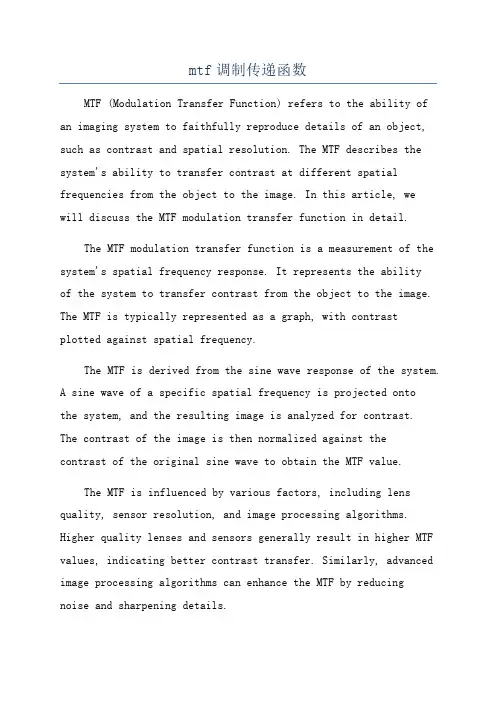
mtf调制传递函数MTF (Modulation Transfer Function) refers to the ability of an imaging system to faithfully reproduce details of an object, such as contrast and spatial resolution. The MTF describes the system's ability to transfer contrast at different spatial frequencies from the object to the image. In this article, wewill discuss the MTF modulation transfer function in detail.The MTF modulation transfer function is a measurement of the system's spatial frequency response. It represents the abilityof the system to transfer contrast from the object to the image. The MTF is typically represented as a graph, with contrastplotted against spatial frequency.The MTF is derived from the sine wave response of the system.A sine wave of a specific spatial frequency is projected ontothe system, and the resulting image is analyzed for contrast.The contrast of the image is then normalized against thecontrast of the original sine wave to obtain the MTF value.The MTF is influenced by various factors, including lens quality, sensor resolution, and image processing algorithms. Higher quality lenses and sensors generally result in higher MTF values, indicating better contrast transfer. Similarly, advanced image processing algorithms can enhance the MTF by reducingnoise and sharpening details.The MTF is often used as a measure of image quality in various fields, including photography, microscopy, and medical imaging. With a higher MTF, the resulting images will havebetter contrast and sharper details, leading to improved image quality and diagnostic accuracy.The MTF is typically measured at various spatial frequencies, ranging from low to high. The MTF graph shows how the system's contrast transfer changes with increasing spatial frequency. A perfect system would have an MTF of 1 at all spatial frequencies, indicating perfect contrast transfer. However, in real-world systems, the MTF gradually decreases with increasing spatial frequency.The MTF graph can provide valuable information about the performance of an imaging system. For example, the spatial frequency at which the MTF drops to a certain value, such as 0.5, is often used as a measure of spatial resolution. A higherspatial resolution indicates that the system can reproducedetails with higher frequency.In conclusion, the MTF modulation transfer function is a crucial measure of image quality. It quantifies the system's ability to transfer contrast at different spatial frequencies.By measuring and analyzing the MTF, one can assess the performance of an imaging system and understand its capabilityto reproduce fine details. With a higher MTF, the system canproduce images with better contrast and spatial resolution, leading to improved image quality and accuracy in various applications.。
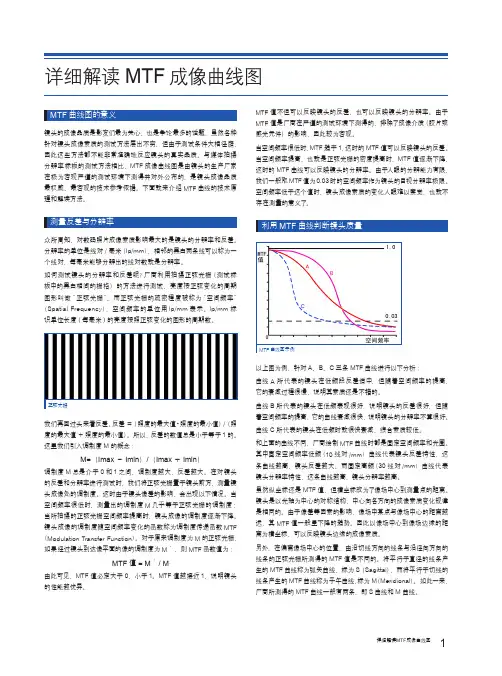
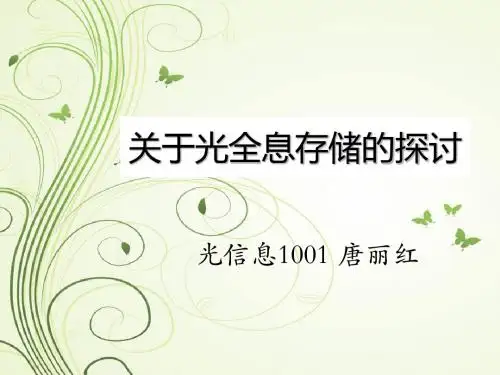
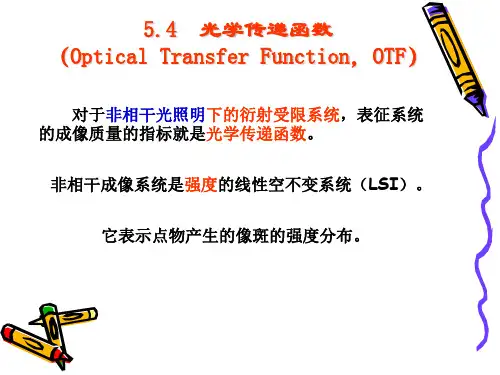
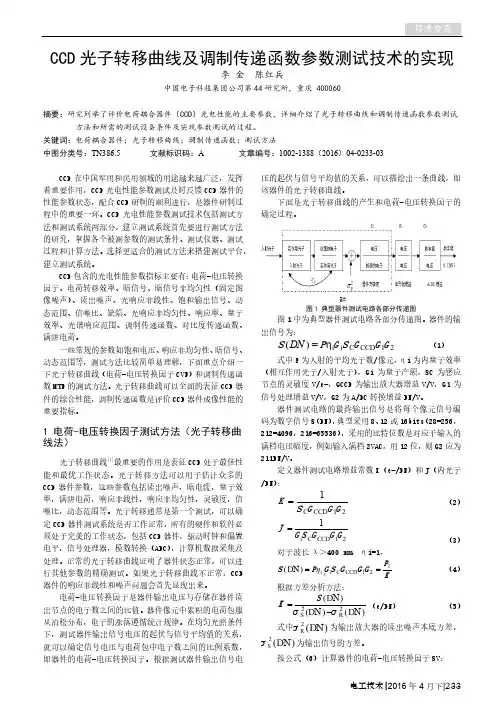
电工技术|2016年4月下|233CCD 光子转移曲线及调制传递函数参数测试技术的实现李 金 陈红兵中国电子科技集团公司第44研究所,重庆 400060摘要:研究列举了评价电荷耦合器件(CCD )光电性能的主要参数,详细介绍了光子转移曲线和调制传递函数参数测试方法和所需的测试设备条件及实现参数测试的过程。
关键词:电荷耦合器件;光子转移曲线;调制传递函数;测试方法 中图分类号:TN386.5文献标识码:A文章编号:1002-1388(2016)04-0233-03CCD 在中国军用和民用领域的用途越来越广泛,发挥着重要作用,CCD 光电性能参数测试及时反馈CCD 器件的性能参数状态,配合CCD 研制的顺利进行,是器件研制过程中的重要一环。
CCD 光电性能参数测试技术包括测试方法和测试系统两部分,建立测试系统首先要进行测试方法的研究,掌握各个被测参数的测试条件、测试仪器、测试过程和计算方法。
选择更适合的测试方法来搭建测试平台,建立测试系统。
CCD 包含的光电性能参数指标主要有:电荷-电压转换因子、电荷转移效率、暗信号、暗信号非均匀性(固定图像噪声)、读出噪声、光响应非线性、饱和输出信号、动态范围、信噪比、缺陷、光响应非均匀性、响应率、量子效率、光谱响应范围、调制传递函数、对比度传递函数、满阱电荷。
一些常规的参数如饱和电压、响应非均匀性、暗信号、动态范围等,测试方法比较简单易理解,下面重点介绍一下光子转移曲线(电荷-电压转换因子CVF )和调制传递函数MTF 的测试方法。
光子转移曲线可以全面的表征CCD 器件的综合性能,调制传递函数是评价CCD 器件成像性能的重要指标。
1 电荷-电压转换因子测试方法(光子转移曲线法)光子转移曲线[1]最重要的作用是表征CCD 处于最佳性能和最优工作状态。
光子转移方法可以用于估计众多的CCD 器件参数,这些参数包括读出噪声,暗电流,量子效率,满阱电荷,响应非线性,响应非均匀性,灵敏度,信噪比,动态范围等。

在MTF图形的设置中,选择显示衍射极限,在图形上可以看到一条黑色的曲线。
针对Focal 和Afocal两种模式,ZEMAX针对衍射极限的计算说名如下:
有以上信息可知,衍射极限由1.22 *λ *F# 决定。
其中λ 为波长,F# 就是我们要讨论的,因为在系统中有好几种F#
Image space F/# - 像空间F/#
Image space F/# is the ratio of the paraxial effective focal length calculated at infinite conjugates over the paraxial entrance pupil diameter. Note that infinite conjugates are used to define this quantity even if the lens is not used at infinite conjugates.
由以上信息可知:像空间F#是系统的有效焦距与入瞳直径的比值,而这两个参数都是以近轴光学为基础的。
而且,这种F#不会因为共轭状态的改变而有任何变化,很显然,MTF 的衍射极限不会以此为准。
近轴工作F/#及工作F/#
近轴工作F/#是以近轴的边缘光线在像空间的角度来计算F/#
工作F/#是以真实的边缘光线在像空间的角度来计算F/#,这个也就是我们的WFNO,其中这个就是计算MTF衍射极限的基础。
其中也要注意,系统计算的WFNO是以第一视场的边缘光学来进行计算的。
因此无论增加几个其他的视场,都不会影响ZEMAX计算的衍射极限。
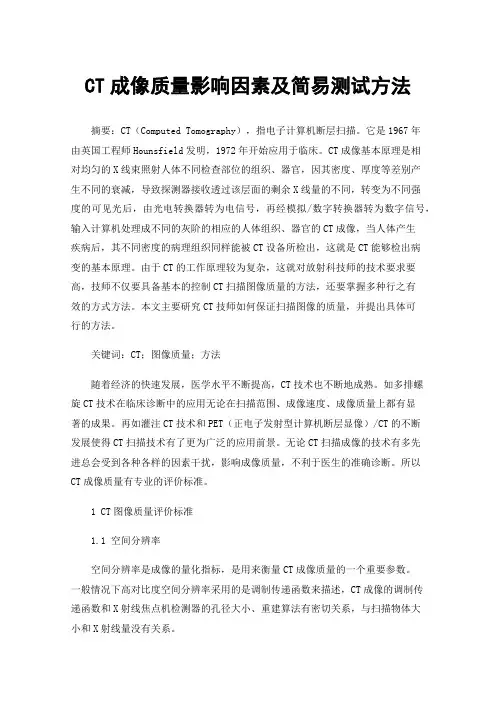
CT成像质量影响因素及简易测试方法摘要:CT(Computed Tomography),指电子计算机断层扫描。
它是1967年由英国工程师Hounsfield发明,1972年开始应用于临床。
CT成像基本原理是相对均匀的X线束照射人体不同检查部位的组织、器官,因其密度、厚度等差别产生不同的衰减,导致探测器接收透过该层面的剩余X线量的不同,转变为不同强度的可见光后,由光电转换器转为电信号,再经模拟/数字转换器转为数字信号,输入计算机处理成不同的灰阶的相应的人体组织、器官的CT成像,当人体产生疾病后,其不同密度的病理组织同样能被CT设备所检出,这就是CT能够检出病变的基本原理。
由于CT的工作原理较为复杂,这就对放射科技师的技术要求要高,技师不仅要具备基本的控制CT扫描图像质量的方法,还要掌握多种行之有效的方式方法。
本文主要研究CT技师如何保证扫描图像的质量,并提出具体可行的方法。
关键词:CT;图像质量;方法随着经济的快速发展,医学水平不断提高,CT技术也不断地成熟。
如多排螺旋CT技术在临床诊断中的应用无论在扫描范围、成像速度、成像质量上都有显著的成果。
再如灌注CT技术和PET(正电子发射型计算机断层显像)/CT的不断发展使得CT扫描技术有了更为广泛的应用前景。
无论CT扫描成像的技术有多先进总会受到各种各样的因素干扰,影响成像质量,不利于医生的准确诊断。
所以CT成像质量有专业的评价标准。
1 CT图像质量评价标准1.1 空间分辨率空间分辨率是成像的量化指标,是用来衡量CT成像质量的一个重要参数。
一般情况下高对比度空间分辨率采用的是调制传递函数来描述,CT成像的调制传递函数和X射线焦点机检测器的孔径大小、重建算法有密切关系,与扫描物体大小和X射线量没有关系。
1.2 噪声噪声主要是指在ct扫描成像过程中亮度水平的波动。
噪声一般会在X射线光子发射过程中或者是吸收转化中出现,限制了系统的检测能力。
信号噪声在被重建算法滤波之后会以影像噪声的形式出现在CT图像上。

第五章 光学系统的质量指标如何评价光学系统的光信息传递质量,即对非成像光学系统的光束传输质量怎样?成像光学系统的成像质量如何?一直是光学工作者极为重视且不断探讨的问题。
如对成像光学系统,传统的评价方法是星点法和分辨率法。
星点检验是观察点光源通过光学系统所得到的像斑形状。
光学系统没有几何像差时,像斑为标准的艾里圆,有几何像差或离焦时,光强分散。
光学系统有中心误差,装配应力或玻璃折射率不均匀等,均会使星点形状不对称或不规则。
但这种方法属主观检验,不同的观察者看法存在差别,是定性和半定量的,它的规定也只能是比较抽象和笼统的。
分辨率法比较简单、方便、意义明确,能够用数量表示。
但它只能表述细节能不能分辨的界限,对于较粗线条的成像质量,不能作出定量的评价,就是说,有两个物镜分辨率一样,但粗线条的明晰度可能不一样。
实际上是一个物镜质量好,一个较差,但分辨率法反映不出来。
此外,尚会出现为分辨情况,测出的分辨率可能比理论分辨率还高。
1900~1904年德国光学工作者哈德曼(Hartman )基于几何像差的概念,用米字形光阑模拟光线,测量除畸变、倍率色差外的其它五种几何像差。
其优点是§测量结果可直接与光线追踪结果相比较。
但它没考虑衍射,且测量工作量大。
此外还有阴影法、干涉法,它们比较适用于非成像光学系统,对于成像光学系统主要用于测量轴上点成象质量,测量范围受限制。
电视出现以后,同样涉及到像质评价问题。
从事电学行业的人和光学行业的人思维模式不同,他们将时域的问题扩展为空域,引入了空间频率的概念。
发现菲涅耳—基尔霍夫衍射积分公式如将积分域拓宽到无穷大恰为傅里叶变换式,从而出现了傅里叶光学,推动了现代光学的发展,这恰恰证明了交叉学科的碰撞出现了科学进步的火花。
对于像质评价则产生了光学传递函数法。
从而使像质评价更为客观、合理。
§ 5.1分辨率如前所述分辨率是以光学系统所能分辨开两垂轴靠近像点的能力为准。
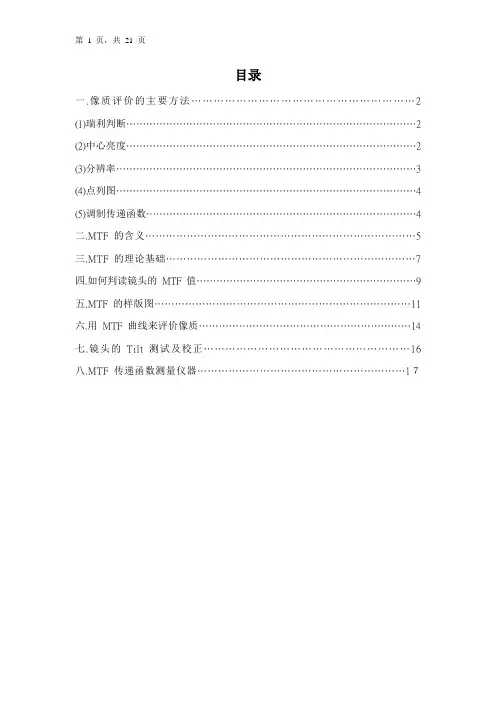
目录一.像质评价的主要方法 (2)(1)瑞利判断 (2)(2)中心亮度 (2)(3)分辨率 (3)(4)点列图 (4)(5)调制传递函数 (4)二.MTF的含义 (5)三.MTF的理论基础 (7)四.如何判读镜头的MTF值 (9)五.MTF的样版图 (11)六.用MTF曲线来评价像质 (14)七.镜头的Tilt测试及校正 (16)八.MTF传递函数测量仪器……………………………………………………17像质评价及MTF的原理说明一.像质评价的主要方法在不考虑衍射现象影响时,光学系统的成像质量主要与系统的象差大小有关,几种光学系统成像质量的评价方法如下(1)瑞利判断是根据成像波面相对理想球面波的变形程度来判断光学系统的成像质量的,瑞利认为“实际波面与参考球面波之间的最大波像差不超过1/4波长时,此波面可看做是无缺陷的.”该判断提出了光学系统成像时所允许存在的最大波像差公差即认为波像差W<1/4波长时,光学系统的成像质量是好的.优点:便于实际应用,因为波像差与几何像差之间的计算关系比较简单,只要利用几何光学中的光路计算得出几何像差曲线,由曲线图形积分便可方便的得到波像差,由所得到的波像差即可判断光学系统的成像质量优劣.反之,由波像差和几何像差之间的关系,利用瑞利判断也可以得到几何像差的公差范围,这对实际光学系统的讨论更有利.缺点:只考虑波像差的最大允许公差,而没有考虑缺陷部分在整个波面面积中所占的比重.如透镜中的小汽泡或划痕,在局部会引起大的波像差,依瑞利判断这是不允许的,但在实际成像过程中,这种局部极小区域的缺陷,对光学成像质量并非有明显影响瑞利判断是一种较为严格的像质评价方法,它主要使用于适用于小像差光学系统.例如:望远镜,显微系统等对成像质量要求较高的系统.(2)中心亮度是依据光学系统存在像差时,其成像衍射斑的中心亮度和不存在像差时衍射斑的中心亮度之比表示光学系统的成像质量.比值用S.D表示,当S.D>=0.8时,认为光学系统的成像质量是完善的这就是斯扥列尔准则,瑞利判断和中心亮度是从不同的角度提出来的象值评价方法,但研究表明,对一些常用的象差形式, 当最大波像差为1/4波长时,中心亮度S.D约为0.8说明这两种评价成像质量的方法是一致的,它也只适用于小像差光学系统,但它计算相当复杂,实际中不便使用.(3)分辨率是反映光学系统能分辨物体细节的能力.由于光的衍射,一个发光点通过光学系统成像后得到一个衍射光斑,两个独立的发光点通过光学系统成像后得到两个衍射光斑,考虑不同间距的两发光点在像面上两衍射像可被分辨与否,就能定量的反应光学系统的成像质量.随两衍射斑中心距变化,出现几种变化.A 两发光物点距离较远,两个衍射斑中心距离较大中间有明显暗区分开,亮暗之间光强对比度k≒1B 有较多重和,重迭部分中心的合光强仍小于两侧的最大光强即0<k<1.C 物点靠近到某一程度时,两衍射斑之间的将大于或等于每个衍射斑中心的最大光强,两衍射斑之间无明显差别k=0.人眼观察相邻两个物点所成的像时,要能判断出是两个像点而不是一个像点,起码要求两衍射斑重迭区的中间与两侧最大光强处要有一定量的明暗差别,即k>0σ=1.22λ/D=1.22λF(瑞利判断)照相系统以像面上刚能分辨两衍射斑中心距的倒数表示分辨率N=1/σ常见的有太阳板和分辨率板,仪器是平行光管,测量时从线条宽度大的单元向线条宽度小的单元顺序观察,找出四个方向的线条都能分辨开的所有单元中单元号最大的单元.根据单元号和分辨率板号查出线条宽度P(mm)平行光管焦距f分辨率a=2P*20626/f(〞)(a)在小像差光学系统(望远系统)实际分辨率几乎只与系统的相对孔径(即衍射现象)有关,受像差影响小,在大像差系统(如照相物镜)分辨率才与系统的象差有关,并常以分辨率作为系统的成像质量标准.(b)分辨率板黑白相间系统与实际物体的亮度有很大差别,同一板来说照明和接收的不同,测量结果也不同.( c)对照相物镜等作分辨率检测时有时出现”伪分辨率现象”即在鉴别某一组系统时不能分辨,但对更密一组条文反而可以分辨,这是因为对比度反转造成的.用分辨率评价光学系统成像质量不是一种严格可靠的评价方法,但由于指标单一,便于测量,在光学系统象质检测中广泛应用.(4)点列图在几何光学成像过程中,由一点发出的许多光线经光学系统成像后,由于像差存在,但其与像面不再集中一点,而是行成一个在一定范围内的弥散图形,称之为点列图.在点列图中利用这些点的密集程度来衡量光学系统的成像质量的方法称之为点列图法.利用点列图法评价照相物镜的成像质量时,通常利用集中30%以上的点或光线所构成的图形区域作为其实际有效弥散斑,其直径倒数为系统的分辨率,利用它需做大量的光路计算,利用计算机才能实现上述任务.常在大像差的照相物镜等设计中应用.(5)调制传递函数上面介绍的几种光学系统成像质量的评价方法,都是基于把物体看作是发光点的集合,并以一点成像时的能量集中程度来表征光学系统的成像质量,.利用光学传递函数来评价光学系统的成像质量,是基于把物体看作是由各种频率的谱组成的,也就是把物体的光场分布函数展开成傅立叶级数或积分的形式.若把光学系统看成是线性不变的系统,那幺物体经光学系统成像,可视为物体经光学系统传递后其传递效果是频率不变,但其对比度下降,相位要发生推移,并在某一频率截止,即对比度为0.这种对比度的降低和相位推移是随频率不同而不同的,其函数关系我们称之为光学传递函数,由于它与光学系统象差有关又与光学系统的衍射效果有关,故用它来评价具有客观性和可靠性,并能同时应用于大小像差光学系统.二. MTF的含义MTF---Modular Transfer Function(调制传递函数)是对镜头的锐度,反差和分辨率进行综合评价的数值。

可变焦距机器视觉镜头光学系统设计刘巧玲;陈丽娜;余华恩;柯华恒;梁秀玲【摘要】在机器视觉系统中,镜头的主要作用是将目标成像在图像传感器的光敏面上。
针对生产过程中机器视觉系统在保持工作距离不变的情况下需获得不同的放大倍数,采用机械补偿形式,利用Zemax软件设计了一款可用于机器视觉的可见光多焦点变焦物镜系统。
该系统工作距离可以在290 m m~340 m m范围内变化,实现了焦距从10 m m~100 m m的10倍多焦点变焦。
设计结果表明:该变焦物镜最大畸变小于1%,最大兼容0.84 cm (1/3英寸)CCD图像传感器。
用调制传递函数对系统的成像性能进行评估,该系统在空间频率100 lp/m m处调制传递函数大于0.3,满足成像要求。
%In machine vision systems ,lens is mainly responsible for imaging object on photosen‐sitive surface of image sensor .Based on machine vision systems ,the mechanical compensated zoom was adopted ,the Zemax software was used to design a visible multifocal zoom lens sys‐tem that could be applied in machine vision systems to address some specific situation w hile dif‐ferent magnification were required but working distance remained unchan ged during produc‐tion .The system has the working distance from 290 mm to 340 mm andthe focal length chan‐ging from 10 mm to 100 mm ,which makes 10 times multifocal zoom possible .The results show s that for this multifocal zoom lens ,the maximum distortion is less than 1% ,and it can best hold 1/3 inch CCD image sensor .The system imaging performance was assessed by modu‐lation transfer function(MTF) ,and MTF is greater than 0 .3 at the frequency of 100 lp/mm , w hich meets the imaging demands .【期刊名称】《应用光学》【年(卷),期】2015(000)002【总页数】7页(P199-205)【关键词】光学设计;变焦系统;机械补偿变焦;机器视觉【作者】刘巧玲;陈丽娜;余华恩;柯华恒;梁秀玲【作者单位】福建师范大学光电与信息工程学院福建省光子技术重点实验室,福建福州350007;福建师范大学光电与信息工程学院福建省光子技术重点实验室,福建福州350007;福建师范大学光电与信息工程学院福建省光子技术重点实验室,福建福州350007;福建师范大学光电与信息工程学院福建省光子技术重点实验室,福建福州350007;福建师范大学光电与信息工程学院福建省光子技术重点实验室,福建福州350007【正文语种】中文【中图分类】TN942.2;O439引言典型的机器视觉系统一般包括光源、光学镜头、智能相机、图像处理单元(或图像采集卡)、图像分析处理软件、监视器、通讯/输入输出单元等。
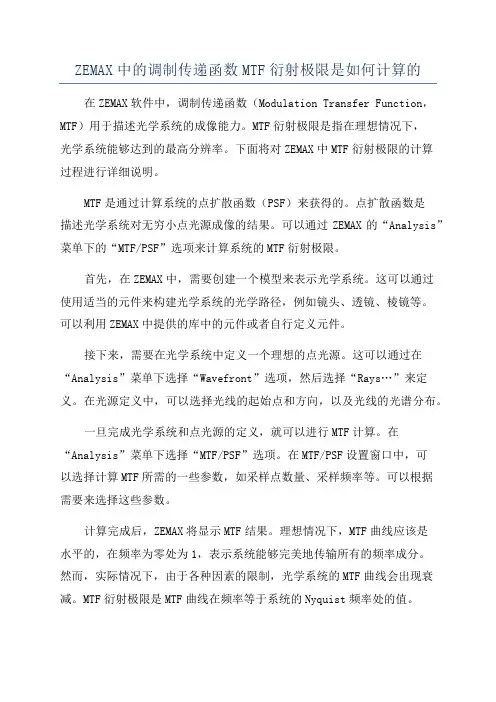
ZEMAX中的调制传递函数MTF衍射极限是如何计算的在ZEMAX软件中,调制传递函数(Modulation Transfer Function,MTF)用于描述光学系统的成像能力。
MTF衍射极限是指在理想情况下,光学系统能够达到的最高分辨率。
下面将对ZEMAX中MTF衍射极限的计算过程进行详细说明。
MTF是通过计算系统的点扩散函数(PSF)来获得的。
点扩散函数是描述光学系统对无穷小点光源成像的结果。
可以通过ZEMAX的“Analysis”菜单下的“MTF/PSF”选项来计算系统的MTF衍射极限。
首先,在ZEMAX中,需要创建一个模型来表示光学系统。
这可以通过使用适当的元件来构建光学系统的光学路径,例如镜头、透镜、棱镜等。
可以利用ZEMAX中提供的库中的元件或者自行定义元件。
接下来,需要在光学系统中定义一个理想的点光源。
这可以通过在“Analysis”菜单下选择“Wavefront”选项,然后选择“Rays…”来定义。
在光源定义中,可以选择光线的起始点和方向,以及光线的光谱分布。
一旦完成光学系统和点光源的定义,就可以进行MTF计算。
在“Analysis”菜单下选择“MTF/PSF”选项。
在MTF/PSF设置窗口中,可以选择计算MTF所需的一些参数,如采样点数量、采样频率等。
可以根据需要来选择这些参数。
计算完成后,ZEMAX将显示MTF结果。
理想情况下,MTF曲线应该是水平的,在频率为零处为1,表示系统能够完美地传输所有的频率成分。
然而,实际情况下,由于各种因素的限制,光学系统的MTF曲线会出现衰减。
MTF衍射极限是MTF曲线在频率等于系统的Nyquist频率处的值。
综上所述,ZEMAX中MTF衍射极限的计算是通过计算系统的点扩散函数来实现的。
可以通过定义光学系统、光源和选择计算参数来进行MTF计算。
计算结果可以用于评估光学系统的分辨能力,并进行系统设计和优化。
点扩散函数与调制传递函数⼀个成像系统可以看作⼀个线性移不变系统,他将理想图像变换为我们所观察到的图像。
相对于与实际相关的线性时不变系统,⼆维图像线性移不变系统不受因果约束。
系统基本特性如下:1)2)1 点扩散函数1)冲击函数采样为⽆限冲击函数,当作⽤与连续函数时,有,推导如下:在区间,有关系式,做如下变换,,结论得证。
根据平移性质,有,对两边同时积分得。
当需要对函数 f(t) 在点采样时,可做如下卷积。
2)图像线性分解对于离散函数,可以写成离散冲击得线性组合。
对于连续函数,定义,。
当,,改写成积分形式为:。
⼆维连续图像函数使⽤⼆维冲击函数线性组合为。
对理想⼆维图像,经过成像系统所得到的结果是⼀个线性变换过程,如果的响应为,则的响应为:。
以上的响应为描述了⼀个理想点经过成像系统后的变化,被称为点扩散函数(Point Spread Function)。
由于成像系统为线性变换,上式实际上表⽰了理想图像与点扩散函数的卷积结果,即。
2 调制传递函数点扩散函数在空域中使⽤卷积来描述成像系统,调制传递函数在频域使⽤乘积描述成像系统。
函数经过成像系统变换为线性变换,使⽤卷积表⽰为。
上式表明,经过成像系统后其频率没有发⽣改变,仅改变了幅度与相位,被称为成像系统的特征函数(类似线性代数中的特征向量)。
同样,对于⼆维图像,特征函数经过线性变换结果为:。
在平⾏线组垂直⽅向上,波长为的余弦波的调制传递函数(Modulation Transfer Function) 为:,使⽤变换描述⼆维频率为的响应幅度与相位。
参考资料 Robot Vision Berthold Klaus Paul Horn。
红外热像仪调制传递函数(MTF)测试技术研究吴铮(昆明物理研究所,云南昆明 650223)摘要:调制传递函数MTF(Modulation Transfer Function)能客观地反映热成像系统的频率响应特性,是评价红外热成像系统性能的重要指标之一。
本文对MTF的测试技术进行研究,通过大量的试验,对MTF的测试过程中的影响因素进行分析,确定影响MTF测试结果的重要因素,改进红外热像仪MTF测试的关键程序,提高测试结果的准确性和一致性。
关键词:红外热像仪;调制传递函数(MTF);MTF测试0 引言红外成像技术已在军事和民用领域得到了广泛的应用,调制传递函数MTF(Modulation Transfer Function)是分析、评价红外成像系统成像性能的重要参数之一,是光学成像系统成像质量的重要指标。
作为红外成像系统重要的评价指标,MTF用于衡量系统如实重现景物图像性能的能力,反映红外成像系统的性能,受到更多的关注。
如何准确地测试系统的MTF,确保测试结果的准确性和一致性,合理评价系统性能,对MTF的测试技术提出了更高的要求。
1MTF测试系统MTF测试系统是一个涉及红外光学、精密机械、数据采集与数字信号处理、计算机等多个领域的复杂系统。
MTF基本测试系统原理如图1所示。
图1 热像仪MTF测试系统示意图2 红外热像仪MTF的测试方法调制传递函数MTF的主要的测试方法有直接测量法和间接测量法。
在整机性能测试设备上进行LSF/MTF测试,通常采用如下测试程序:1)将待测热像仪调整到最佳(如:调节电平、对比度、极性、焦距、监视器的性能);2)选择目标靶,对焦距为2000mm的测试系统来看,宽视场用SL2目标靶(靶宽0.35mm),窄视场用SL1目标靶(靶宽0.1mm),调整示波器,设置温差;3)进行等效阵列长度的校准;4)进行LSF的测试;5)背景扣除;6)去除抖动;7)MTF的计算;8)MTF的校正;9)显示保存结果;10)MTF的计算及修正:对LSF傅里叶变换,归一化(0~1.0)得出曲线图。
图像质量参数术语介绍1.色彩还原(Color Accuracy)又叫色彩精度,即相机还原真实色彩的能力,是影响图像质量的一个重要因素。
相机还原色彩的能力并非任何情况下都是越强越好,比如有些用户喜欢饱和度增强的色彩,但这时高精度的颜色不一定令人愉快。
对于色彩测试,重要的是测量相机的色差,也就是其颜色偏移,色彩饱和度和白平衡效果等。
2.色偏(Color Error)又叫色差,是指拍摄的图像中某种颜色的色相、饱和度与真实的图像有明显的区别,而这种区别通常不是人们所希望的。
色差△Eab =1时称为1个NBS(美国国家标准局的缩写)色差单位。
1个NBS单位大约相当于视觉色差识别阈值(颜色宽容度)的5倍。
3.色彩饱和度(Saturation)指色彩的鲜艳程度,也称作纯度。
在色彩学中,原色饱和度最高,随着饱和度降低,色彩变得暗淡直至成为无彩色,即失去色相的色彩。
4.白平衡误差(White Balance Error)简单来说就是“在不同光源条件下,成像系统的白平衡功能都能将白色物体显示为白色”。
事实上,白平衡是通过对白色被摄物的颜色还原(产生纯白的色彩效果),进而达到其他物体色彩准确还原的一种数字图像色彩处理的计算方法。
相机的白平衡设定可以校准色温带来的偏差,在拍摄时我们可以大胆地调整白平衡来达到想要的画面效果。
5.曝光误差(Exposure Error)为了验证camera在不同亮度等级的光照场景下都能有合适的曝光效果,一般会分别在强光、中光和弱光条件下进行拍摄测试分析。
对于AE(自动曝光)模式的成像系统来说,做曝光误差的测试可以有效提前预防一些曝光误差带来的不良画面效果。
比如常见的画面曝光不足(欠曝),尽管亮部区域层次丰富,但是暗部丢失细节;又或者是画面过曝,高光区域一片白,无层次、无信息。
影响曝光的三要素包括:ISO感光度、快门速度(即曝光时间)、光圈大小。
每个设置以不同方式控制曝光。
光圈:控制光线可以进入相机的区域,光圈越大,曝光量越多,画面越亮。
1.理想光学系统:一个理想光学系统应能使一个点物发出的球面波通过光学系统后仍然是一个球面波,从而理想的交与一点。
一个理想光学系统应能使一个点物发出的所有光线通过光学系统之后仍然能够交于一点,理想观雪系统同时满足直线成像直线,平面呈像平面。
P12.像差:所谓像差就是光学系统所成的实际像与理想像之间的差异。
P13.视场:光学系统中描述成像范围大小的参量称为视场,系统对近距离物体成像时,视场的大小一般用物体的高度y表示,对远距离物体成像时,视场大小用视场角表示。
P4视场光阑:光学系统中用于限制成像范围大小的光阑称为视场光阑。
入窗:视场光阑经前面的光组在物空间所成的像称为入射窗;出窗:视场光阑经后面的光组在像空间所成的像称为出射窗;入射窗与物面重合,出射窗与像面重合。
出射窗是入射窗经整个系统所成的像。
4.孔径:描述成像光束大小的参量称为孔径。
系统对近距离物体成像时,其孔径大小用孔径角U表示,对无限远物体成像时,孔径大小用孔径高度h表示。
孔径光阑:光学系统中用于限制轴上点成像光束大小的光阑称为孔径光阑,孔径光阑的大小决定成像面上的照度。
入瞳:孔径光阑通过其前面光学系统所成的像称为入瞳,它决定进入系统光束的大小,入瞳是物面上所有各点发出的光束的共同入口;出瞳:孔径光阑通过它后面光学系统所成的像称为出瞳,决定从系统出射光束的大小,出瞳是物面上各点发出光束经整个光学系统以后从最后一个光孔出射的共同出口。
注意:入瞳、孔径光阑、出瞳三者相互共轭。
5.渐晕:实际光学系统视场边缘的像面照度一般允许比轴上点适当降低,也就是轴外子午光束的宽度比轴上点光束的宽度小,这种现象叫做“渐晕”。
P56.位置色差:描述两种色光对轴上物点成像位置差异的色差称为位置色差或轴向色差;倍率色差:因不同色光成像倍率的不同而造成物体的像大小差异的色差称为倍率色差或垂轴色差。
(光学系统对不同色光的放大率的差异称为倍率色差。
)色球差:高级位置色差实际上就是球差的色变化,这就是色球差的概念。
Modulation Transfer Function (MTF) and MTF Curves
MTF curves show resolution and contrast information simultaneously allowing a lens to be evaluated based on the requirements for a specific application and can be used to compare the performance of multiple lenses. Used correctly, MTF curves can help determine if an application is actually feasible. For information on how to read an MTF curve, seeLens Performance Curves. Figure 1 is an example of an MTF curve for a 12mm lens used on the Sony IXC 625 sensor, which has a sensor format of 2/3" and 3.45μm pixels. The curve shows lens contrast over a frequency range from 0 lp/mm to 150 lp/mm (sensor’s limiting resolution is 145lp/mm). Additionally, this lens has its f/# set at 2.8 and is set at a PMAG of 0.05X, which yields a FOV of approximately 170mm for 20X the horizontal dimensions of the sensor. This FOV/PMAG will be used for all examples in this section. White light is used for the simulated light source.
Figure 1: MTF curve for a 12mm lens used on the Sony IXC 625 sensor. This curve provides a variety of information. The first thing to note is that the diffraction limit is represented by the black line. The black line indicates that the maximum theoretically possible contrast that can be achieved is almost 70% at the 150lp/mm frequency, and that no lens design, no matter how good, can perform higher than this. Additionally, there are three colored lines: blue, green, and red. These lines correspond to how this lens performs across the sensor in the center (blue), the 0.7X position at 70% of the full field on the sensor (green), and the corner of the sensor (red), respectively. It is clearly shown that at lower and higher frequencies contrast reproduction is not the same across the entire sensor and, thus, not the same over the FOV.
Additionally, it can be seen that there are two green and two red lines. These lines represent the tangential and sagittal contrast components associated with detail reproduction that is not in the center of the FOV. Due to aberrational effects, a lens will produce spots that are not completely round and will therefore have different sizes in the horizontal and vertical orientation. This size variation leads to spots blending together more quickly in one direction than the other, and produces different contrast levels in different axes at the same frequency. It is very import to consider the implications of the lower of these two values when evaluating a lens for a given application. It is generally advantageous to maximize the contrast level across the entire sensor to gain the highest levels of performance in a system.
COMPARING LENS DESIGNS AND CONFIGURATIONS Example 1: Comparison of two different lens designs with the same focal length (fl), 12mm, at f/2.8 Figure 2 examines two different lenses of the same focal length that have the same FOV, sensor, and f/#. These lenses will produce systems that are the same size but differ in performance. In analysis, the horizontal light blue line at 30% contrast on Figure 2a demonstrates that at least 30% contrast is achievable essentially everywhere within the FOV, which will allow for the entire capability of the sensor to be well-utilized. For Figure 2b, nearly half the field is below 30% contrast. This means that better image quality will only be achievable at half of the sensor. Also to note, the orange box on both curves represents the intercept frequency of the lower performance lens in Figure 2b with 70% contrast. When that same box is placed on Figure 2a, tremendous performance difference can be seen even at lower frequencies between the two lenses.
The difference between these lenses is the cost associated with overcoming both design constraints and fabrication variations; Figure 2a is associated with a much more complex design and tighter manufacturing tolerances. Figure 2a will excel in both lower resolution and demanding resolution applications where relatively short working distances for larger field of view are required. Figure 2b will work best where more pixels are needed to enhance the fidelity of image processing algorithms and where lower cost is required. Both lenses have situations where they are the correct choice, depending on the application.